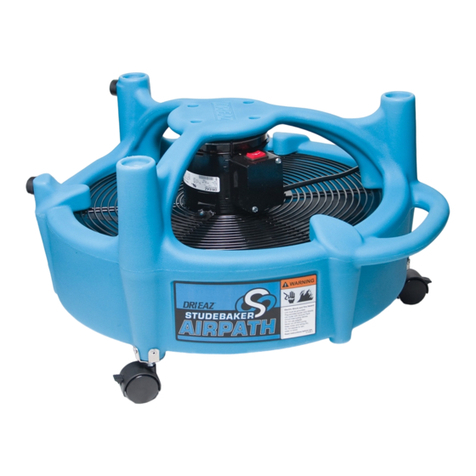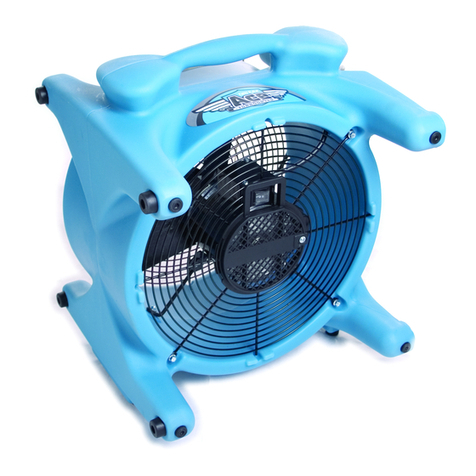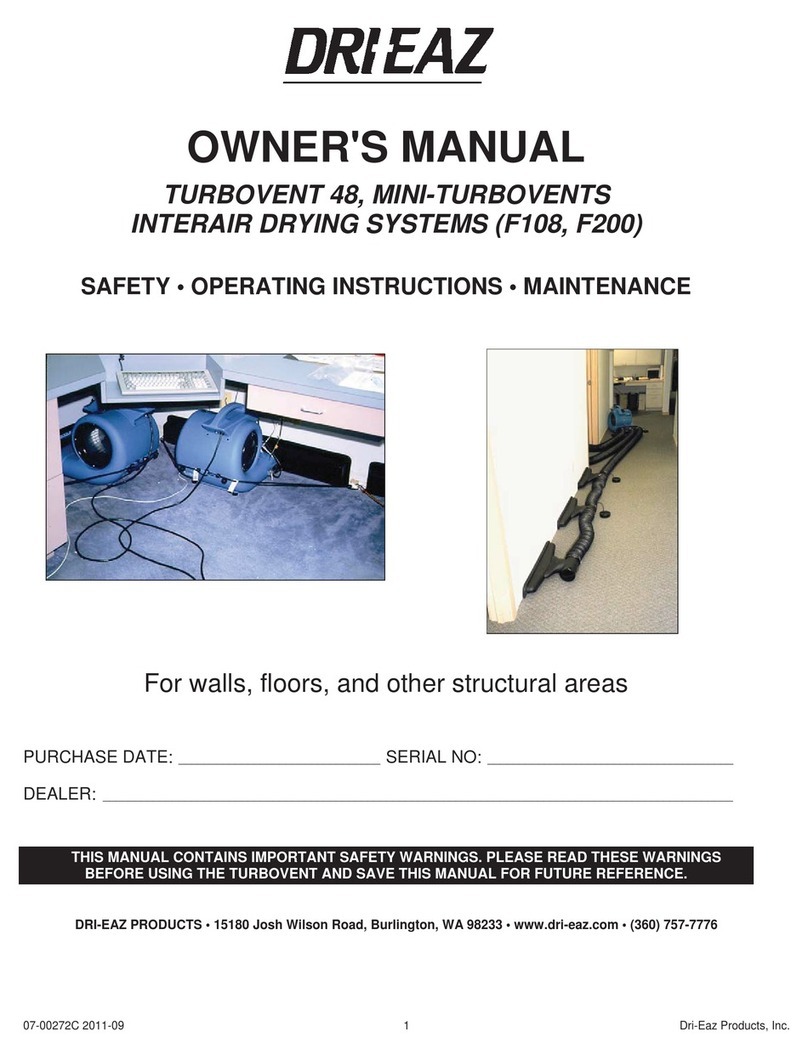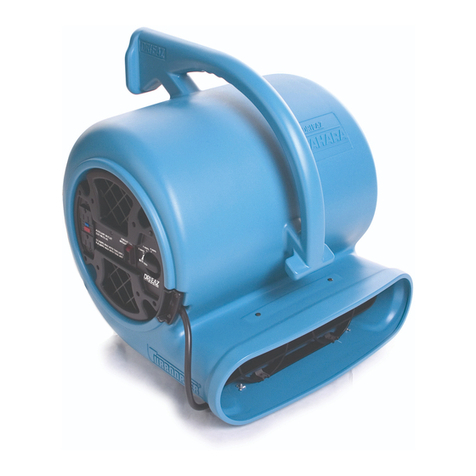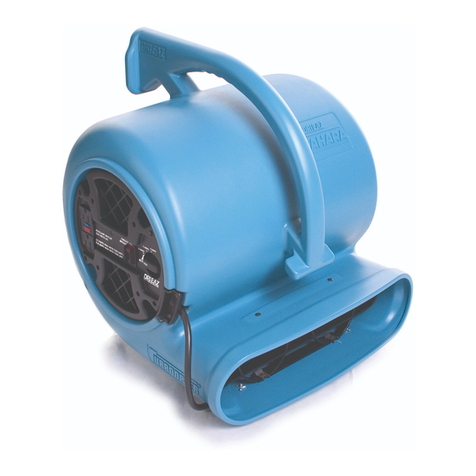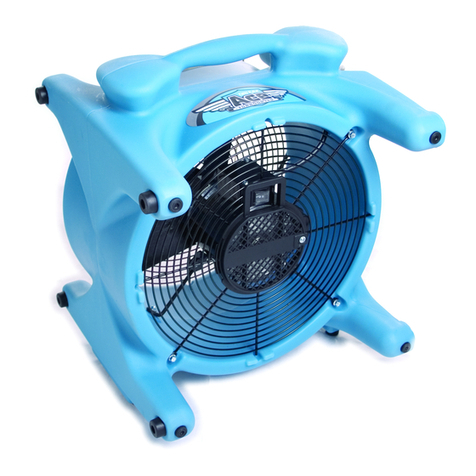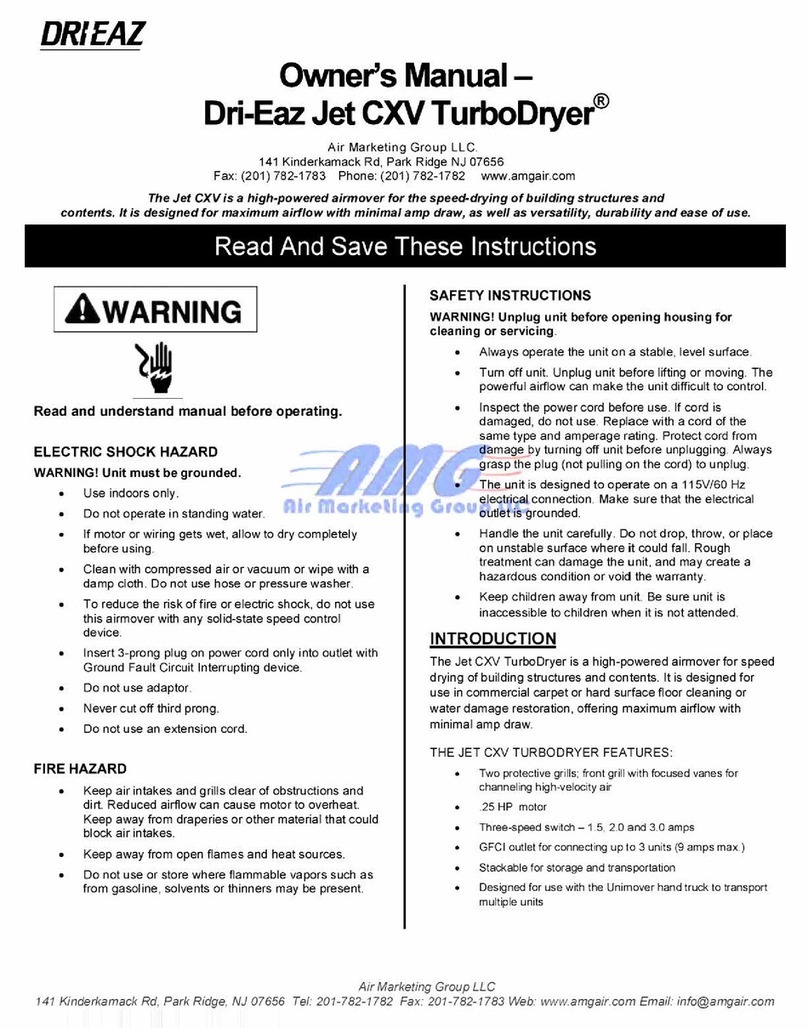
When drying hardwood or structural wood, the
DriTec Desiccant is recommended because of its
capacity to reduce interior humidity even below 5%
Rh. Such exceptionally low humidity speeds up the
drying of moisture from dense materials which give up
moisture slowly.
9. Monitor Progress
As drying progresses, swelling and buckling should
subside. TurboVents may have to be moved occasion-
ally to reach slow drying sections of floor. A moisture
meter should be used to check and monitor the
moisture content of flooring.
10. Completing the Job
After the flooring is dry, the floor may need to be
sanded and refinished by a qualified technician. Upon
completion of refinishing, the baseboards and moldings
should be replaced to cover the ventilation gaps.
Effective Drying Area of Hardwood Flooring
One TurboVent 48 can effectively dry a section of
floor 48 inches or 4 feet wide; each Mini-TurboVent
can dry a section 24 inches or 2 feet wide. Either
method will dry a section of flooring approximately 10
to 12 feet long. If the section of floor is longer than 12
feet, you may need to use TurboVents at one end and
then move them to the opposite end of the floor.
Always check drying progress with a good moisture
meter.
Never direct two TurboVents towards one another
on the same section of floor; the airflows collide and
defeat each other, lowering evaporation.
Typically, any major water damage will require
multiple TurboVents. An important point to remember
is that time is extremely important; the faster you get
the wood dry the less chance there will be for perma-
nent damage.
With TurboVents there is generally no need for a
complete removal or refinishing of the hardwood.
Costs are reduced by eliminating the need for replacing
hardwood and finishes.
CAUTION
Do not allow children to play with or around the
TurboDryers. Be sure the TurboDryer is inaccessible to
children when left unattended. Secure all areas in
which TurboDryers are left unattended while running.
Surface Drying Hardwood Floors
While subsurface drying improves drying results,
the surface of the flooring provides a secondary
location for evaporation to occur. Already mentioned
are the difficulties in surface drying caused by buckling
action and impermeable wood finishes. There is a
method, however, to minimize damage to the finish
(and thereby minimize refinishing expense) while
increasing the overall rate of evaporation.
Using a wallpaper perforation roller, the surface of
the floor can be perforated with thousands of small
holes. These holes puncture the impermeable floor
finish, permitting water vapor to escape or evaporate
from the surface of the wood. After perforating,
TurboDryers should be placed in several locations so
that they blow air across the surface of the floor.
Dehumidifiers should also be used to reduce the
humidity in the area being dried. As mentioned earlier,
the moisture content of wood seeks equilibrium with
the humidity in the air. The dryer the air, the faster the
water evaporates from the wood.
Dehumidification equipment significantly speeds
the drying process. DrizAir refrigerant dehumidifiers
will often reduce relative humidity to about 40%. A
DriTec desiccant dehumidifier may reduce humidity to
under 10%, which is very helpful in rapid drying of all
woods including hardwood floors.
Tenting a Hardwood Floor
"Tenting" a hardwood floor can speed drying even
when TurboVents are used. The aim when tenting is to
reduce the amount of air being dried. Any
dehumidifier, and especially a DriTec Desiccant, will
reduce the humidity lower under a tent than when
forced to dry an entire room or structure.
Cover the affected area with sheet plastic, and
fasten securely with 2" painter's tape or other method.
TurboVents may be covered completely by the tent so
they use the super-dry air.
A DrizAir refrigerant dehumidifier may sometimes
be completely covered by the tent to trap the dry air it
is producing. However, the temperature under the tent
must be monitored, and not allowed to exceed 100°F
(38°C).
When using a DriTec desiccant dehumidifier, place
the DriTec outside the tent, and duct the warm, dry
process air into one corner of the tent. Connect a duct
to another corner of the tent and fasten the other end to
the air inlet (filter) of the DriTec. This forms a "closed
loop" that continuously dries the air under the tent, and
can bring the specific humidity below 10 grains per
pound. Leave a small opening in the ducting where it
enters the air inlet of the DriTec, to make up for the
reactivation air that is leaving the dehumidifier but not
entering the tent.
Permanent Damage to Hardwood Flooring
If the surface of the floor remains stressed in a
cupped, crowned or buckled condition after drying is
completed, it may remain so. In these cases, complete
resanding or even replacement will be needed,
followed by refinishing. Ensure that the moisture




